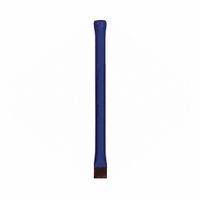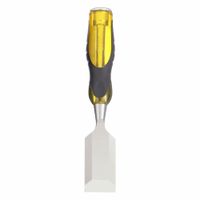Call +(254) 703 030 000 / 751 483 999 / 721 704 777
- Home
- Tools
- Hand Tools
- Punching Tools Chisels
- Chisels Sets
.....Read More
Frequently Asked Questions
What are the different types of chisels and their uses?
1. **Bevel Edge Chisel**: Ideal for woodworking, especially for cutting dovetails and cleaning out joints due to its angled edges.
2. **Mortise Chisel**: Designed for heavy-duty work, it is used to cut mortises and can withstand mallet blows.
3. **Paring Chisel**: Long and thin, used for delicate wood shaving and fine paring work, typically pushed by hand rather than struck.
4. **Firmer Chisel**: Strong and robust, used for general woodworking tasks, with a rectangular cross-section.
5. **Butt Chisel**: Shorter blade, used for work in tight spaces and for trimming and fitting.
6. **Corner Chisel**: L-shaped blade, used for cleaning out corners of mortises and other square holes.
7. **Dovetail Chisel**: Similar to bevel edge chisels but with a narrower blade, used specifically for cutting dovetail joints.
8. **Slick Chisel**: Large paring chisel used in timber framing, often with a long handle for leverage.
9. **Skew Chisel**: Blade is angled, used for cutting and trimming in tight or awkward spaces.
10. **Japanese Chisel (Nomi)**: Known for its sharpness and durability, used in fine woodworking and joinery.
11. **Cold Chisel**: Made of hardened steel, used for cutting metal and stone, not wood.
12. **Cape Chisel**: Narrow blade, used for cutting keyways and slots in metal.
13. **Round Nose Chisel**: Used for carving and shaping concave surfaces in wood.
14. **V-Gouge Chisel**: V-shaped blade, used for carving and creating decorative patterns.
15. **Flat Chisel**: Used for general metalwork, removing waste material, and shaping.
Each chisel type is designed for specific tasks, ensuring precision and efficiency in various materials and applications.
How do you sharpen a chisel properly?
To sharpen a chisel properly, follow these steps:
1. **Preparation**: Gather necessary tools: a sharpening stone (coarse and fine grit), honing guide, lubricant (water or oil, depending on the stone), and a strop.
2. **Secure the Chisel**: Attach the chisel to a honing guide to maintain a consistent angle, typically 25 to 30 degrees.
3. **Lubricate the Stone**: Apply water or oil to the sharpening stone to reduce friction and prevent metal particles from clogging the surface.
4. **Coarse Grit Sharpening**: Start with the coarse grit side of the stone. Place the chisel bevel down, ensuring the entire bevel is in contact with the stone. Push the chisel forward across the stone, applying even pressure. Repeat until a burr forms on the opposite side of the bevel.
5. **Fine Grit Sharpening**: Flip the stone to the fine grit side. Repeat the same process to refine the edge and remove the burr. This step polishes the bevel and enhances sharpness.
6. **Flatten the Back**: Lay the chisel flat on the stone, back side down. Move it back and forth to ensure the back is flat and smooth, which is crucial for a sharp edge.
7. **Honing**: Use a strop with polishing compound to further refine the edge. Pull the chisel back across the strop, bevel side down, to polish and remove any remaining burr.
8. **Test the Edge**: Check sharpness by slicing through paper or shaving wood. A properly sharpened chisel should cut effortlessly.
9. **Maintenance**: Regularly hone the chisel to maintain sharpness and reduce the need for frequent sharpening.
What is the best material for a chisel blade?
High-carbon steel is often considered the best material for a chisel blade due to its excellent balance of hardness, toughness, and edge retention. This type of steel contains a higher percentage of carbon compared to other steels, which allows it to be hardened to a greater degree. This hardness is crucial for maintaining a sharp edge, which is essential for precise cutting and carving tasks.
Additionally, high-carbon steel is tough enough to withstand the impact and stress that chisels are subjected to during use. This toughness helps prevent the blade from chipping or breaking, ensuring durability and longevity. The ability to easily sharpen high-carbon steel is another advantage, allowing users to maintain a keen edge with minimal effort.
While high-carbon steel is susceptible to rust, regular maintenance such as cleaning and oiling can mitigate this issue. Some chisels are also made from alloy steels, which include elements like chromium and vanadium to enhance corrosion resistance and toughness. However, these may not achieve the same level of sharpness as high-carbon steel.
For specialized applications, such as woodworking or stone carving, tool steel or tungsten carbide may be used. Tool steel offers excellent wear resistance and toughness, while tungsten carbide provides extreme hardness and durability, though it is more brittle and difficult to sharpen.
In summary, high-carbon steel is generally the preferred choice for chisel blades due to its superior edge retention, toughness, and ease of sharpening, making it suitable for a wide range of applications.
How do you maintain and care for chisels?
To maintain and care for chisels, follow these steps:
1. **Cleaning**: After each use, wipe the chisel with a clean cloth to remove any debris or moisture. For stubborn residues, use a mild solvent.
2. **Sharpening**: Regularly sharpen chisels using a sharpening stone or honing guide. Start with a coarse grit to reshape the edge, then move to finer grits for honing. Maintain a consistent angle, typically 25-30 degrees, for the bevel.
3. **Honing**: After sharpening, hone the chisel on a leather strop or fine honing stone to polish the edge and remove burrs.
4. **Rust Prevention**: Apply a thin coat of oil, such as camellia or mineral oil, to the metal parts to prevent rust. Store chisels in a dry place, ideally in a tool roll or with silica gel packs.
5. **Handle Care**: For wooden handles, apply linseed oil occasionally to prevent drying and cracking. For plastic handles, ensure they are clean and free from cracks.
6. **Storage**: Store chisels in a protective case or rack to prevent damage to the edges. Ensure they are not in contact with other tools.
7. **Usage**: Use chisels only for their intended purpose. Avoid prying or using them as screwdrivers to prevent damage.
8. **Inspection**: Regularly inspect chisels for damage or wear. Replace or repair any damaged parts, such as chipped edges or loose handles.
By following these steps, you can ensure your chisels remain sharp, functional, and long-lasting.
What safety precautions should be taken when using chisels?
1. **Wear Protective Gear**: Always wear safety goggles to protect your eyes from flying chips and gloves to protect your hands.
2. **Inspect Tools**: Check chisels for any damage, such as cracks or dull edges, before use. Ensure the handle is securely attached.
3. **Sharpen Regularly**: Keep chisels sharp to reduce the risk of slipping. A dull chisel requires more force and increases the chance of accidents.
4. **Use Proper Technique**: Hold the chisel firmly with a proper grip. Use a mallet instead of a hammer to strike the chisel, as it provides better control.
5. **Secure Workpiece**: Clamp the workpiece securely to prevent movement while chiseling.
6. **Cut Away from Body**: Always chisel away from your body to avoid injury if the tool slips.
7. **Stable Position**: Maintain a stable stance and ensure your work area is clear of obstructions.
8. **Controlled Force**: Apply controlled force to avoid losing control of the chisel.
9. **Store Safely**: Store chisels with blade guards or in a tool roll to prevent accidental cuts.
10. **Keep Work Area Clean**: Ensure the work area is free of debris to prevent slips and falls.
11. **Avoid Distractions**: Focus on the task at hand and avoid distractions to maintain control.
12. **Use Correct Chisel**: Select the appropriate chisel for the task to ensure efficiency and safety.
13. **Avoid Overreach**: Do not overreach; maintain a comfortable working distance to prevent loss of balance.
14. **Regular Maintenance**: Regularly maintain chisels to ensure they are in good working condition.
15. **Training**: Ensure you are properly trained in using chisels to understand the risks and correct handling techniques.
How do you choose the right chisel for a specific task?
To choose the right chisel for a specific task, consider the following factors:
1. **Type of Chisel**:
- **Bench Chisels**: Ideal for general woodworking tasks like cutting, paring, and chopping.
- **Mortise Chisels**: Designed for cutting mortises due to their thick, robust blades.
- **Paring Chisels**: Long, thin blades for delicate, precise work and paring tasks.
- **Firmer Chisels**: Stronger and thicker, suitable for heavy-duty work.
- **Butt Chisels**: Short blades for working in tight spaces.
2. **Blade Material**:
- **High-Carbon Steel**: Holds a sharp edge longer, suitable for hardwoods.
- **Alloyed Steel**: Offers a balance between durability and edge retention.
- **Stainless Steel**: Resists rust but may require more frequent sharpening.
3. **Blade Width**:
- Narrow blades (1/8" to 1/4") for fine, detailed work.
- Medium blades (1/2" to 3/4") for general tasks.
- Wide blades (1" and above) for removing large amounts of material.
4. **Handle Type**:
- **Wooden Handles**: Traditional feel, good for controlled work.
- **Plastic or Composite Handles**: Durable and resistant to impact, suitable for heavy use.
5. **Task Requirements**:
- For **fine joinery**, use paring chisels or bench chisels with sharp, narrow blades.
- For **mortising**, choose mortise chisels with thick blades.
- For **rough work**, firmer chisels or heavy-duty bench chisels are appropriate.
6. **Ergonomics**:
- Ensure the chisel feels comfortable in your hand and provides good control.
7. **Budget and Quality**:
- Invest in high-quality chisels for frequent use to ensure durability and performance.
By considering these factors, you can select the appropriate chisel for your specific woodworking task.
What are the differences between wood chisels and metal chisels?
Wood chisels are designed specifically for woodworking tasks. They typically have a sharper, thinner blade made from high-carbon steel, which allows for precise cutting and shaping of wood. The handles are often made from wood or plastic and are designed to be struck with a mallet. Wood chisels come in various types, such as bench chisels, mortise chisels, and paring chisels, each suited for specific woodworking tasks.
Metal chisels, on the other hand, are intended for cutting and shaping metal or stone. They are made from tougher, more durable materials like hardened steel to withstand the greater force required for metalwork. The blades are thicker and less sharp compared to wood chisels, as they need to endure the impact of a hammer or sledgehammer. Metal chisels include types like cold chisels, which are used for cutting cold metal, and hot chisels, which are used on heated metal.
The key differences lie in the materials, blade design, and intended use. Wood chisels are optimized for precision and fine detail in softer materials, while metal chisels are built for durability and strength to handle harder materials.



